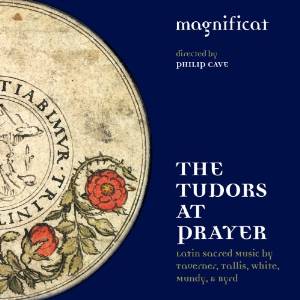
It was another year full of great classical music. Here are my favorites from 2014, new releases only, no reissues.
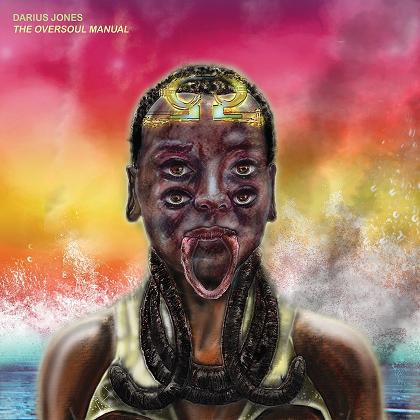 2. The Elizabeth-Caroline Unit
2. The Elizabeth-Caroline Unit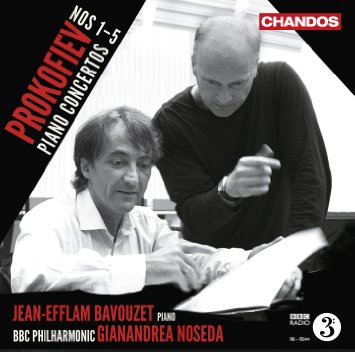 3. Jean-Efflam Bavouzet/BBC Philharmonic/Gianandrea Noseda
3. Jean-Efflam Bavouzet/BBC Philharmonic/Gianandrea Noseda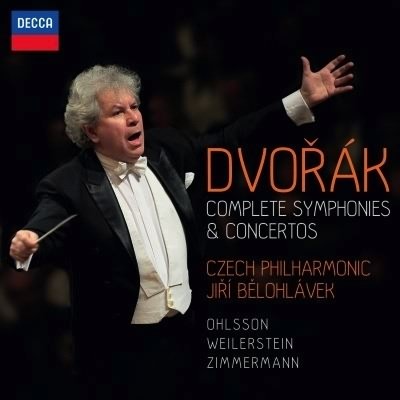 4. Alisa Weilerstein/Frank Peter Zimmermann/Garrick Ohlsson/Czech Philharmonic/Jirí Belohlávek
4. Alisa Weilerstein/Frank Peter Zimmermann/Garrick Ohlsson/Czech Philharmonic/Jirí BelohlávekThe new top recommendation for a complete set of the symphonies is certainly the best-sounding set, highly detailed (a function not only of the engineering but also of the conductor's attention to detail) yet also warm. It also, crucially, does full justice to the underrated symphonies before the famous 7-9, even making the first three sound good. Time and again, the orchestra's echt-Czech tones combine with Belohlávek's shaping of the music to present Dvorák's tuneful themes with a piquant songfulness that brings out their wistful melancholy in all its psychologically layered glory. Belohlávek's tendency to breadth is balanced by his general omission of exposition repeats (he only takes them in the more tightly wound Fourth and Fifth Symphonies), which I'm in agreement with. The concerto soloists are uniformly excellent. In particular, the Piano Concerto, which so often seems awkward, here is graceful and charming.
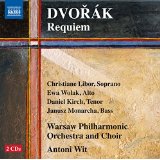 5. Christiane Libor/Ewa Wolak/Daniel Kirch/Janusz Monarcha/Warsaw Philharmonic Orchestra & Choir/Antoni Wit
5. Christiane Libor/Ewa Wolak/Daniel Kirch/Janusz Monarcha/Warsaw Philharmonic Orchestra & Choir/Antoni WitDvořák'sRequiem, though a great work, requires considerable mastery in performance to put it across. It's a bit long even by Requiem standards, and a bit grimmer and lighter on consolation than any other Requiem in the standard repertoire; it's quite demanding of both soloists and orchestra; and its music is not especially ingratiating. That may not make it sound like something you'll want to listen to, but the good news is that Wit -- who achieves superstar results nearly every time out yet somehow still flies under the radar -- conjures just the right tempos to make it flow, assembles a magnificent quartet of soloists, and as usual makes his Warsaw Philharmonic sound like one of the top orchestras in the world. Its woodwinds glint darkly, its brass glow with burnished fire, and its choir can stand with the best. This joins the classic Kertész account on Decca at the top of the heap, but with a more characterful orchestral sound. (This is a two-disc set with just 98 minutes of music, no filler, but with Naxos being a low-cost label, that's okay.)
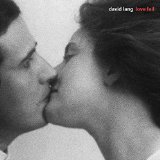 6. Anonymous 4
6. Anonymous 4A number of Minimalist composers whose instrumental works I enjoy nonetheless stumble when setting words -- or, at least, don't match my tastes in word-setting. David Lang is a welcome exception (Reich is another). There's a gracefulness to Lang's settings, even as his music deliberately makes listeners a bit uneasy, that absolutely entrances me. Female vocal quartet Anonymous 4 (soon to retire from performance, alas) adeptly handles the hazards of Lang's tricky and exposed lines, with their slippery dissonances and stark pauses. This album has been seen by some as a near-sequel to Lang's masterpiece, The Little Match Girl Passion, given the similarities of performing forces (four voices and bells [though Love Fail also includes a little percussion]), and of course Lang's compositional style, but Love Fail has a very different impact, more intimate and personalized. It's heartbreaking not in the historical-trope fashion of Passion, but in a this-could-happen-to-you-or-me way that makes it psychologically painful to attentively listen to, though if you just put it on in the background and don't pay attention to the words, it's lovely.
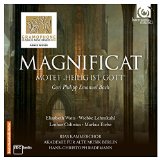 7. Elizabeth Watts/Wiebke Lehmkuhl/Lothar Odinius/Markus Eiche/RIAS Kammerchor/Akademie für Alte Musik Berlin/Hans-Christoph Rademann
7. Elizabeth Watts/Wiebke Lehmkuhl/Lothar Odinius/Markus Eiche/RIAS Kammerchor/Akademie für Alte Musik Berlin/Hans-Christoph RademannFinally C.P.E.'s superb Magnificat (written in 1749, supposedly as a sort of audition to take over his father's job in Leipzig) gets a period-performance recording that fully makes the case for its excellence. Odinius occasionally pushes his tone a bit too hard, but other than that the soloists are wonderful, the RIAS Chamber Choir is wonderful as usual, Akademie für Alte Musik Berlin sounds better than I've ever heard them before, and Rademann's apt tempos leave plenty of room for the expressive moments while getting maximum thrills out of the joyful uptempo sections and plenty of brio in the sparkling climaxes of majesty. There's also a shorter, more modern choral work and one of C.P.E.'s later symphonies to fill out the album, as well as the overview of his styles.
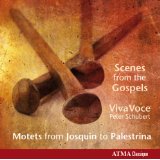 8. Viva Voce/Peter Schubert
8. Viva Voce/Peter SchubertReaders with good memories may recall that in this article culturecatch.com/music/album-year-1961-2010-classical (see 2005) I mentioned that I studied with the conductor of this group. But though my bias made me pick this CD out of the piles that accumulate over the course of the year thanks to friendly publicists, its goodness is unconnected to my bias. This is an interesting program of 16th century choral music, with composers ranging from the famous (Josquin des Prez, Palestrina) to the favorites of aficionados (Gombert, Willaert, Manchicourt) to two new to me (Jacquet of Mantua, Michele Pesenti AKA Michael of Verona). Schubert, who literally wrote the book on this kind of polyphony (really: Modal Counterpoint, Renaissance Style [Oxford University Press]), and his Montreal-based twelve-singer choir mold these pieces beautifully, "warming up" notes and phrases without overdoing the "hairpin dynamics" the way the Hilliard Ensemble did after a while. Dynamics, blends, and balances are impeccable; no fan of Renaissance choral music should pass this album by.
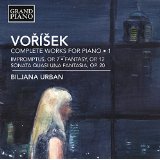 9. Biljana Urban
9. Biljana UrbanNaxos' prolific piano-centric sub-label has exposed us to a plethora of under-heard music over the past few years. Bohemian composer Jan Václav Hugo Voříšek (1791-1825), known in recent decades (though only among cognoscenti) for two masterpieces, his sole symphony and his Mass in B-flat major, died of tuberculosis at just 34 years of age. His less-known piano output, though championed by a few performers, has never to my knowledge been taken up by a top-tier virtuoso, presumably due to Voříšek's obscurity. Here, however -- more than when played by the competition -- his works come off as significant expressions of early Romanticism. (Voříšek was influenced by Beethoven and was friends with Schubert.) In particular, Urban plays Op. 20 with magnificent breadth and weight. The Impromptus, by the way, were published in 1822 and were apparently an influence on Schubert's subsequent Impromptus (pub. 1827). Voříšek's are thoroughly enjoyable on their own terms.
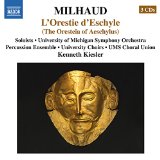 10. Lori Phillips (Clytemnestra/Ghost of Clytemnestra)/Dan Kempson (Orestes)/Sidney Outlaw (Apollo)/Kristin Eder (Electra)/Julianna Di Giacomo (Pythia); etc./UMS Choral Union/University of Michigan Chamber Choir/University of Michigan University Choir/University of Michigan Orpheus Singers/University of Michigan Percussion Ensemble/University of Michigan Symphony Orchestra/Kenneth Kiesler
10. Lori Phillips (Clytemnestra/Ghost of Clytemnestra)/Dan Kempson (Orestes)/Sidney Outlaw (Apollo)/Kristin Eder (Electra)/Julianna Di Giacomo (Pythia); etc./UMS Choral Union/University of Michigan Chamber Choir/University of Michigan University Choir/University of Michigan Orpheus Singers/University of Michigan Percussion Ensemble/University of Michigan Symphony Orchestra/Kenneth KieslerSome classical fans will be familiar with Les choéphores, recorded most memorably by Igor Markevitch and Leonard Bernstein; far fewer will have heard L'Agamemnon and Les euménides. To have recorded all of these Aeschylus settings together for the first time is a spectacular accomplishment. So while this three-CD set is not quite a perfect package (Kempson's vibrato is wilder and woollier than I like), merely having such a welcome release of this weird, savage, and compelling music is enough. (One reviewer lamented the lack of a libretto [by the great French poet Paul Claudel] and translations, but though omitted from the booklet, these are available on the Naxos website.) Milhaud's polytonal mastery and his colorful orchestration make for many striking moments, Phillips and Outlaw deliver fine performances, and the much-featured choirs handle the harmonically demanding music with aplomb. Opera fans looking for change-of-pace repertoire will find this just as rewarding as Strauss's better-known Elektra. And considering that I'm not even that much of an opera devotee and I find this absolutely enthralling, even non-opera fans should consider picking up this highly dramatic and musically rewarding set.
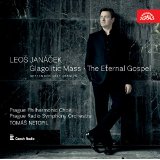 11. *Andrea Danková/Jana Sykorová/Tomáš Juhás/Jozef Bendi; #Alzbeta Polácková (Angel)/Pavel Cernoch (Joachim da Fiore); Prague Philharmonic Choir/Prague Radio Symphony Orchestra/Tomáš Netopil
11. *Andrea Danková/Jana Sykorová/Tomáš Juhás/Jozef Bendi; #Alzbeta Polácková (Angel)/Pavel Cernoch (Joachim da Fiore); Prague Philharmonic Choir/Prague Radio Symphony Orchestra/Tomáš NetopilIn the past, there has been at least one edition, and apparently a few others, purporting to be the original version of the Glagolitic Mass, but apparently the one edited by Jiří Zahrádka, referred to as the September 1927 version, is the most authentic; it is recorded here for the first time. Czech conductor Tomáš Netopil has already impressed in Janáček, and based on this recording he appears to be a rising star. It's not made clear exactly what the differences are, but here and there I catch bits that sound more rhythmically complex or a little more dissonant harmonically. The overall impression is of a more feral and passionate piece; certainly this recording sounds great in all possible ways -- interpretation, execution, and sonics. We also get a different coupling than usual, a 1914 piece about a monk receiving from an Angel a vision of the coming kingdom of love. I've never heard another composer's work that sounds like Janáček's, and this program conveys that distinctiveness pungently.
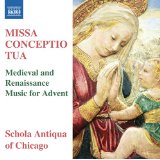 12. Schola Antiqua of Chicago/Michael Alan Anderson
12. Schola Antiqua of Chicago/Michael Alan AndersonYeah, Naxos had a pretty good year! I was listening to this for a possible 2014 holiday music article, but became so infatuated with this CD's world premiere recording of Missa Conceptio Tua by Pierre de la Rue (c.1452-1518) and the wonderful tone of the low basses that I couldn't resist saving it for this list instead. The other half of the program here consists of the seven ancient chants referred to as the O Antiphons, the later chant Alma Redemptoris Mater, and three familiar late Medieval English carols: "There is no rose of swych vertu," "Hail Mary, full of grace," and "Nova, nova!"
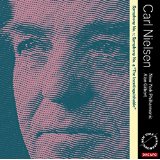 13. New York Philharmonic/Alan Gilbert
13. New York Philharmonic/Alan GilbertThe New York Philharmonic is a perfect match for Nielsen's music, since both are craggy, muscular, mercurial, and exuding nerve-wracking tension. That's not to say Maestro Gilbert doesn't deserve credit for channeling those traits in a finely proportioned way; the keenly honed precision of the rhythms here is key. His ongoing project of recording them is one of the most valuable cycles currently in progress. With No. 4 "Inextinguishable" -- perhaps the best known of them -- on the 2014 installment, and the NYP's brass at their best in its powerful first movement, if you haven't checked out this cycle yet, this is a great place to start.
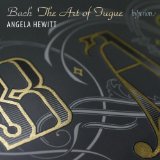 14. Angela Hewitt
14. Angela HewittThis Canadian pianist recorded 17 CDs of Bach's keyboard works before finally approaching his monumental The Art of Fugue. It is a difficult work to put across; it's a whole lot of D minor and a whole lot of canons and fugues, which at the least are an acquired taste, though those of us who love Bach have enjoyed acquiring it. Somehow under Hewitt's fingers The Art of Fugue loses the stiffness of academic demonstration and comes alive not as a series of puzzles, but as an ecstatic exploration of cosmic complexity. Her sensitive phrasing, her subtle shadings of timbre, her slight touch of rubato, her rhythmic snap, all combine to make this not just easy to listen to, but absolutely compelling.
 15. Jennifer Koh/Shai Wosner
15. Jennifer Koh/Shai WosnerThough this has a 2013 copyright, I'm pretty sure it arrived in 2014. It's an unusual program; violinist Koh and pianist Wosner only play together on the sonatas and Tre Pezzi. The remaining ten Kurtág pieces are a mix of selections from his sets Signs, Games and Messages for solo violin and Játékok (Games)for solo piano (with a small vocal component on two of those heard here, by Koh if I'm not mistaken). Based on the album title, the emphasis could seem to be on the Kurtág material, but it is the bookending older pieces that dominate by virtue of both size and charisma. Koh and Wosner really brings out the passion of the Janáček, the former with luscious slides between notes, the former with sensitive dynamics, both with Romantic tempo fluctuations and surges. In the more mysterious, even ominous, world of the Bartók, Koh conveys its mercurial moods with a wide range of timbres. Coming between those two masterpieces, the mostly short Kurtág pieces (half under a minute) offer a playful change of pace both stylistically and sonically.
Most Overrated
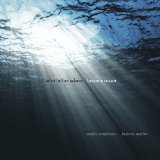 Seattle Symphony Orchestra/Ludovic Morlot
Seattle Symphony Orchestra/Ludovic Morlot